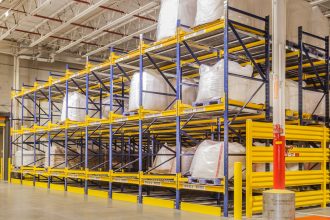How Pallets Contribute To The Safe Use Of Pushback Rack Systems

As with the vast majority of industrial steel storage rack systems, last-in/first-out (LIFO) pushback racking systems are designed for use with specific pallet types, loads and rack configurations. Operators, therefore, should be trained to only load a pushback system with the pallets that have been approved for use within the structure. Using pallets with different dimensions or construction styles can increase the risk of the load not being seated securely on the cart within its lane.
Because pushback rack systems utilize the pallet loads themselves to push each load and its cart backwards into the lane as new ones are added, both pallet and load integrity are essential. Damaged pallets or those with broken, split or cracked bottom boards, or exposed fasteners can cause a load to become snagged or hung up within its lane. Loads that have not been properly unitized or stretch wrapped to secure the contents can also become caught up in the system. A pallet load with overhanging slip sheets, carton flaps, loose stretch wrap, improperly stacked cartons, or boxes that have been jarred out of position can snag easily within the system, causing a jam.
Such a situation can negatively impact the system’s safety, structural integrity and smooth operation because of how pushback rack is designed. These systems are engineered to leverage a combination of friction between the pallets and their loads, the pushback carts and rails, and any physical skid stops and/or beam stops that keep pallets in place. Any debris or obstruction from a pallet, or the presence of a foreign material — such as ice, lubricants or liquid — on the pushback rails or carts can potentially reduce the friction between the pallet and the pushback system. The loss of friction can result in the pallets sliding forward. Therefore, the integrity of each lane should be maintained with periodic inspection of the rails and the carts and cleaning as needed.
Additionally, it is important to never mix load weights within a single lane of pushback rack. Because different pallet weights generate different degrees of friction within the lane, mixed loads can increase the potential for a heavier pallet to push a lighter one out of alignment or out of the system entirely. This is a dangerous situation that increases the risk of system failure, product damage or injury to personnel.
Learn more about how to safely use pushback rack systems, here.


